Sat 8 Sep 2012
A Fellow Saunterer
Posted by Bob under Hiking/Sauntering, Nature
No Comments
Sat 8 Sep 2012
Posted by Bob under Hiking/Sauntering, Nature
No Comments
Wed 8 Aug 2012
Posted by Bob under Chickens, Family and Friends, Hiking/Sauntering
No Comments
Above: John and family posing, eating, walking, reading, and (Calista) feeding crickets to the chickens during a visit in early August.
Above: Eleanor loving our chickens!
Above: Rafey Habib and family at Crabtree Falls and at Saunders during peach season.
Thu 2 Aug 2012
Posted by Bob under Appalachian Trail, Family and Friends, Hiking/Sauntering, Nature, Travel
No Comments
This post will mix reminiscences about three traverse attempts across the Presidential Range of New Hampshire’s White Mountains: a winter traverse with the Harvard Mountaineering Club way back in January 1963; a planned June 2007 traverse with five family members which an ill-timed accident prevented me from participating in; and the backpacking trip last week with my two sons Nic and Tim and their wives Alison and Megan. Each of these trips was interrupted by Mt. Washington’s famously bad weather, but with my climb over Mt. Pierce and up Mt. Madison with Nic (pictured above with Mt. Adams in the background), I finally completed the ascent of all the “president” Presidentials.
Origins
It seems almost insane in retrospect, but as a Harvard freshman with some hiking but no real mountaineering experience, I participated in what was then a Harvard Mountaineering Club (HMC) tradition: a winter traverse of the Presidential range at the end of January, in the break between semesters. My memories are a bit hazy, but I know that we hiked up to a cabin quite high on the side of Mt. Adams on the first day, and then continued, with snowshoes and crampons, the next day over the summits of Adams, Jefferson and Clay to the side of Mt. Washington, where we pitched tents outside the (boarded up) Lake of the Clouds AMC hut. I believe that we hiked up late that afternoon to the weather observatory on the summit of Mt. Washington, where the meteorologists, unused to visitors that time of year, invited us in for a short visit. It was a cold night back in our tents! The next day we continued on over the various summits to what was then called Mt. Pleasant (later renamed Mt. Eisenhower). Here we ran into a ferocious snow storm with very high winds, and we were literally blown off the mountain, making an unplanned descent of its eastern side. My main memory of that descent is crossing a field of young conifers on my snowshoes, and falling through the snow into the air pockets created by branches under the snow, getting the snowshoes tangled up in the branches. But somehow we made it through and out.
The 2007 Expedition
As noted above, I did not get to go on the 2007 hike, but it too was interrupted by bad weather. Having climbed the Mt. Webster-Jackson trail out of Crawford Notch, going over Mts. Webster and Jackson and staying at Mizpah Hut the first night, the group (Cally, Sylvia, Nic, Alison and Justin, along with Lee Spiller who took the picture above) had beautiful weather for the stretch along the AT onward to Lake of the Clouds Hut. But the next day (in June!) brought freezing temperatures, snow and sleet, and a decision was made to come down the trail that ends up at the cog railway station, not risking the very exposed route over the northern Presidentials to the Madison Spring Hut.
click here for a YouTube video of their second day
2012: A Detour and a Completion
This past week, our party of five followed the Crawford Path from Crawford Notch up to Mizpah Spring Hut and the AT, where we spent our first night. The next day, which started in the fog but cleared up nicely, we continued over Mts. Pierce, Eisenhower and Monroe and then on to Lake of the Clouds Hut, where we spent the night. Since Alison has led tours at President Monroe’s home, Ashlawn, climbing Mt. Monroe (5372′) was a special moment, and she was pleased that Mt. Monroe, with its two peaks, compares very well to the other southern Presidentials.
The next morning we hiked up to the summit of Mt. Washington, the highest mountain (6288′) in the U.S. northeast. The weather worsened at the summit, however, and after waiting two hours to see if it would get better (it didn’t), we reluctantly arranged to take a van down to our car at Pinkham Notch. We then drove around to the Valley Trail up to Madison Spring Hut (seeing a mother moose and her calf along the way). Coming on top of our climb up Mt. Washington in the morning, the hike up the Valley Trail proved to be an exhausting one (with a 3500 feet elevation increase), but we all made it while dinner at the hut was still in progress. In the morning, Nic and I climbed Mt. Madison, which along with Mt. Pierce, belatedly completed for me the Presidentials that the Harvard Mountaineering Club traverse had not covered. The weather partly cleared at the top, giving us beautiful views of the clouds below and the summit of nearby Mt. Adams. We all hiked out later in the afternoon and headed to my sister Eleanor’s place in the Catskills. Overall, a great trip, and my thanks to Nic and Tim for conceiving and organizing it.
click here for more pictures of the 2012 trip
click here to learn more about the AMC huts
Wed 30 May 2012
Posted by Bob under Appalachian Trail, Hiking/Sauntering, Nature
No Comments
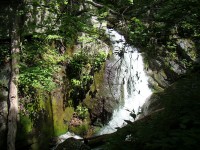 A new waterfall for me, that is. By now I’ve hiked a good proportion of the trails around here, but the Mau Har Trail in the Three Ridges Wilderness Area was a new one for me. Departing from the AT about two miles in, it leads one up and down until it reaches a series of Waterfalls on Campbell Creek, on the western side of Three Ridges Mountain, one of the two highest in the region. At about 6 1/2 miles round trip, it’s a nice short day hike. The mountain laurel and rhododendron were past their prime at the lower elevations, but there was a nice array of wildflowers to enjoy along the way.
A new waterfall for me, that is. By now I’ve hiked a good proportion of the trails around here, but the Mau Har Trail in the Three Ridges Wilderness Area was a new one for me. Departing from the AT about two miles in, it leads one up and down until it reaches a series of Waterfalls on Campbell Creek, on the western side of Three Ridges Mountain, one of the two highest in the region. At about 6 1/2 miles round trip, it’s a nice short day hike. The mountain laurel and rhododendron were past their prime at the lower elevations, but there was a nice array of wildflowers to enjoy along the way.
Thu 12 Jan 2012
Posted by Bob under Appalachian Trail, Hiking/Sauntering, Nature
No Comments
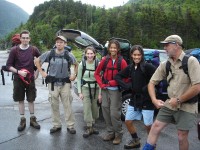 Â
 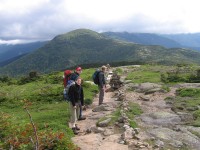
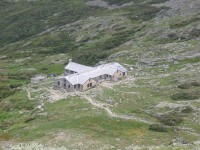
Above: the 2007 expedition team en route to Lake of Clouds Hut
In June 2007, an annoying accident prevented me from being part of a family hike I’d planned on the Appalachian Trail in the White Mountains, New Hampshire, staying at Appalachian Mountain Club huts along the way. This year Nic and Tim have sweetly taken it upon themselves to organize a repeat of the hike this summer. It’s planned for this coming July and I’m very much looking forward to it! [Note: pictures from the 2007 expedition can be seen in three pages at our family website, and there’s also a YouTube video of the second day based on pictures taken by Nic, Alison, Cally, Sylvia, Justin, and my brother-in-law Lee, who fortunately was available to take my place.]
So barring another stupid accident, it’s up to me (now as a retired old geezer) to keep up with Nic and Alison and Tim and Megan this July! Accordingly, I officially began today my “training” for the hike this summer with a six-mile saunter up our local Crabtree Falls and beyond to Crabtree Meadow and back. Although there were touches of ice here and there, the temperatures were in the fifties and rain earlier in the week meant lots of water in the falls. And the lack of foliage meant that the falls were visible through the trees at all times.  Above the falls, the trail runs along the floodplain of Crabtree Creek, which below the falls feeds into the South Fork of the Tye River. There is a nice mountain laurel forest and pleasant campsites along the way. An auspicious beginning for my training regime! A few pictures of today’s hike below.
Thu 27 Oct 2011
Posted by Bob under Hiking/Sauntering, Nature
No Comments
Above: Views along Route 56 en route to the Spy Rock trailhead. Note: Nelson County has more cattle than people: roughly 19,700 vs. 14,500.
With hunting season only days away (which effectively closes most hiking trails around here), I returned yesterday to Spy Rock, which I’d last climbed with Nic, Felix, and Cally last May. While there were still nice fall colors and views of The Priest on the way up route 56, most leaves had fallen on the trail up to Spy Rock and on the surrounding mountains. Still, as always, I was struck by how wild and beautiful Virginia looks from this vantage point.
Mon 24 Oct 2011
Posted by Bob under Hiking/Sauntering, Nature
No Comments
  Â
 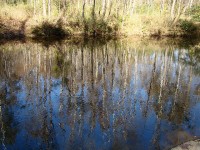
Recently I took a walk along the rails-to-trails path along the Piney River, which marks the southern boundary of Nelson County. I was pleased to observe that several benches have been added along the section between Rose Mill and Route 29, and by one of them these reflections caught my eye.
Mon 29 Aug 2011
Posted by Bob under Family and Friends, Hiking/Sauntering, Nature
No Comments
While Hurricane Irene wreaked a lot of havoc along the Virginia coast this past Saturday, we were only mildly affected in Nelson County. By evening the off-and-on rain showers and winds were gone, and Sunday was a beautiful day. Nic and I headed off for a 5.5 mile hike in neighboring Amherst County, where we follwed the Henry Lanum loop trail up to the two peaks of Mount Pleasant, and then on over Pompey mountain. Thanks to the spector of Irene, we had the trail and the summits mostly to ourselves. The views from the east and west (windy!) summits of Mt. Pleasant are among the most spectacular in the region. Above: fortunately this tree that Irene’s winds had blown down across the forest service road left enough space for us to get past.
Sat 23 Jul 2011
Posted by Bob under Hiking/Sauntering, Nature, Rants
1 Comment
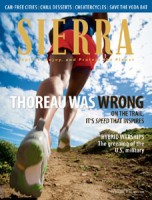 As a longtime Sierra Club member, I was both dumbfounded and appalled by the cover story of the July/August issue: “Thoreau Was Wrong: On The Trail It’s Speed That Inspires.” The article, it turned out, never mentioned Thoreau and was not nearly as bad as the cover suggested, even if I fail to share the author’s enthusiasm for running barefoot on mountain trails.
As a longtime Sierra Club member, I was both dumbfounded and appalled by the cover story of the July/August issue: “Thoreau Was Wrong: On The Trail It’s Speed That Inspires.” The article, it turned out, never mentioned Thoreau and was not nearly as bad as the cover suggested, even if I fail to share the author’s enthusiasm for running barefoot on mountain trails.
But the sheer pretentiousness, stupidity and outrageousness of the magazine cover was highlighted by the fact that about the same time I came across the following quote by none other than the founder and first President of the Sierra Club, John Muir: “‘Hiking’ is a vile word. You should saunter through the Sierra.” So did the Sierra magazine editors consider Thoreau a safe stand-in for John Muir?
Muir notwithstanding, I do use the term “hiking,” but I’m increasingly shifting to “sauntering,” both as a literary choice and as an outdoor practice. Here in the Blue Ridge we do have extraordinary vistas, but so much of the beauty and fascination of this place is found at the micro level, often right at foot level. “Sauntering” captures a mode of this type of discovery.
So saunterers of the world: Unite and throw off the chains of speed and faddishness!
Note: The Muir quote is from Stephen Fox, John Muir and His Legacy: The American Conservation Movement (Little Brown, 1981), p. 120.
Fri 15 Jul 2011
Posted by Bob under Appalachian Trail, Hiking/Sauntering, Nature
No Comments
I hiked the last twenty or so miles of the Appalachian Trail in Nelson County, along with a couple extra miles to McCormick Gap in Shenandoah National Park, in two day hikes on June 30 and July 14. At some points, the AT weaves itself around the border of Nelson and Augusta counties, but remains mostly in Nelson.
The first 10 miles or so is mostly in the woods, but offers nice views, mainly of the Shenandoah Valley, at periodic rocky outcroppings. The one mountain along the way, Humpback Mountain (3600 feet) is wooded at the summit, but offers striking views of the Wintergreen resort from the south side, and a nice overlook and interesting rock formations on its north side. The most spectacular place in this section, Humpback Rocks, is .3 miles off the AT on a side trail. The jagged rocks themselves vie with the view for the top attraction.
The next ten miles offer pleasant hiking through a predominantly Oak-Hickory forest. Here one’s focus is drawn more to the immediate environment: the woodland flowers and their pollinators, remnants from the hardscrabble life of early mountain settlers, the almost-constant “tea” call of the Eastern Towhee and (if you’re lucky like I was) the sight of the strikingly large and colorful Pileated Woodpecker.
The final mile is jarring: suddenly one is crossing Interstate 64 on an overpass, with its roar of traffic, which remains audible for the last mile or so as the AT follows along the Augusta-Nelson border as its heads towards McCormick Gap.
After Monika (my trusty transportation team) picked me up, we repaired to the local brewery, Devils Backbone, where Three Ridges Mountain dominates the view from the outdoor veranda.